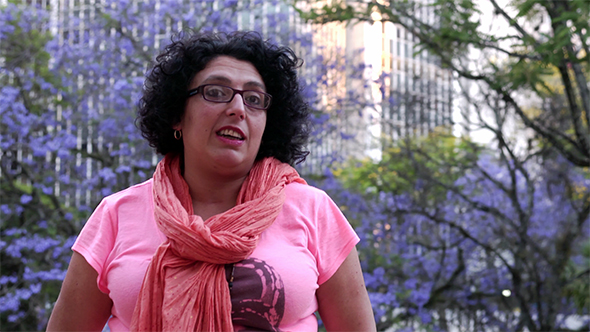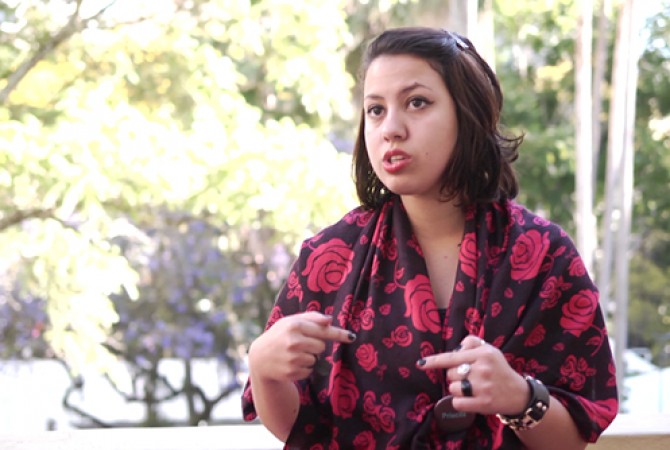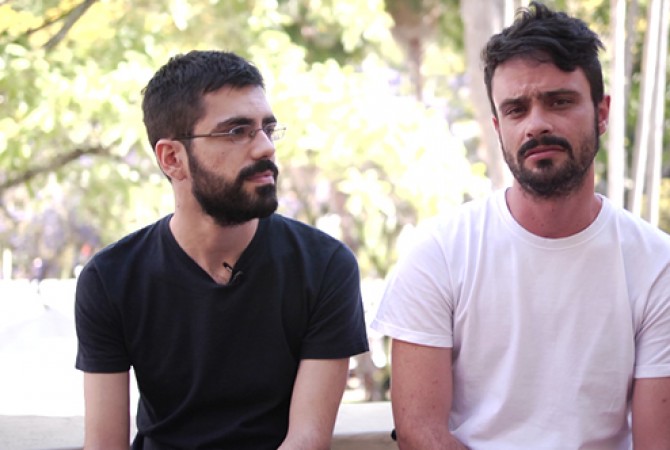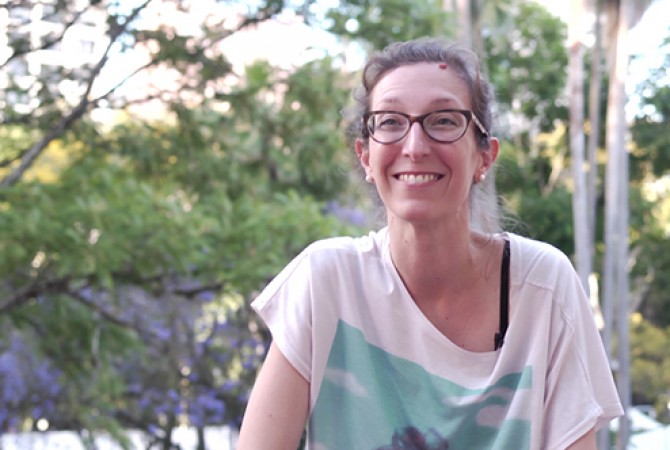
Ana Laura Lopez, artist. Statement “The Meanings of Publicness in Art.” Regional encounter, November 7th, Porto Alegre, 2013, 9th Mercosul Bienal. Filmstill: André Oliveira/Leandro Almeida.
The Meanings of Publicness in Art1 | Introduction and video
9th Mercosul Biennial, Porto Alegre, Brazil
When we were invited by Instituto MESA to participate as regional collaborators from the South on the project Publicness in Art, we were caught up in a kaleidoscopic question: what are the meanings of the words public, publicness and art that make up the name of the project? Or better, what are the many meanings of publicness in art? Faced with this mise em abyme, nothing seemed better than to pass the problem on and to listen in on how different people responded to this polyphonic question.”
Diana Kolker and Rafa Éis2
The project Publicness in Art aimed to reflect on the esthetic and ethical complexities of what constitutes publicness in art and how to characterize, explore and think about public engagement with contemporary artistic production focusing on three distinct Brazilian contexts and regions: Rio de Janeiro, Porto Alegre and Juazeiro do Norte, Sertão.3
In the city of Porto Alegre in Brazil’s southern state of Rio Grande do Sul, video statements were collected reflecting on the meanings of publicness in art in the context of the 9th Mercosul Biennial, Weather Permitting. The project was developed in collaboration with the independent curator and educator Mônica Hoff, also former coordinator of the pedagogic project of the Mercosul Biennial Foundation and one of the curators of the 9th Biennial, and with the artists/educators, Diana Kolker and Rafa Éis (members of the art and education collective Coletivo E) who also had collaborated with the pedagogic project on this and other Mercosul biennials.
Artists, curators, educators, mediators, architects, public relations officers, and researchers involved in some way or another in the 9th or other editions of the biennial were invited to participate and, over the course of one day on the November 7th, 2013, a few days prior to the 9th biennial’s closing, their diverse reflections were recorded on film.
The resulting video presented here is an edited selection of these reflections. Approximately 25 minutes in duration, the video was directed by Diana Kolker and Rafa Éis and edited by Leandro Almeida. [At present the video is only available in Portuguese.]
Many thanks to all the participants: Alberto Gomez Garcia, Ana Cristina Meneghetti, Annaline Curado, Ariela Dedigo, Bruna Fetter, Bruno Salvaterra, Dandara Cagliari, Daniela Kern, Diana Kolker, Estevão da Fontora Haeser, Fabricio Sortica, Luciana Loponte, Luciano Montanha, Marcio Lima, Maria Soledad Mendez, Michel Flores, Michele Sommer, Monica Hoff, Nadia Campos Alíbio, Priscila Costa Oliveira, Rafael Silveira, Silvia Carneiro, Welignton Ricardo Machado da Silva and Valquiria Prates.
Also, a special thank you to André Oliveira for his camera work and to Gabriela Silva, Luciane Bucksdricker and Ana de Carli for their production assistance.
In addition to the video, Mônica Hoff, Diana Kolker and Rafa Éis have contributed essays that reflect on the theme and draw on their experiences with the biennial.
_
1 “The Meanings of Publicness in Art” is a free translation of the name of the regional encounter in Portuguese, “Os sentidos do sentido do público na arte”, which playfully engaged with the overall project title in Portuguese “O Sentido do Público na Arte”. ‘Sentido’ in Portuguese has several meanings: sense and direction as well as meaning. For this reason the project title was translated in English as “Publicness in Art” with the goal of opening up an understanding of “the public” as a qualitative and relational dimension, beyond quantifiable notions of numbers and audiences, or predetermined places or buildings. The Porto Alegre encounter title of “Os sentidos do sentido do público na arte” literally means “The meanings of the meaning of the public in art”, and draws on the multiple meanings of “sentido” in Portuguese and in turn, similarly emphasizes this qualitative relational possibility suggested by the word “publicness”.
2 Email communication, November 2014.
3 Publicness in Art was a series of regional seminars coordinated by Instituto MESA and funded by the 10th edition of the Brazilian National Art Foundation’s (Funarte) grant initiative, Networks of Encounters in the Visual Arts. The series aimed to reflect on the ethical and aesthetic complexity and public roles and possibilities of contemporary artistic production in three distinct national regions and contexts: a) city and periphery of Rio de Janeiro/State of Rio de Janeiro b) Porto Alegre/State of Rio Grande do Sul and c) Juazeiro do Norte, Cariri/Sertão region/State of Ceará. Each regional seminar assumed a distinctly different format and thematic focus and was planned in collaboration with local institutions, artists, curators, and educators: Rio de Janeiro with Casa Daros and the institution’s manager of art and education, Bia Jabor, former director of art and education Eugenio Valdés Figueroa, and Art is Education program coordinator, Roberta Condeixa; Porto Alegre with independent curator/educator Mônica Hoff, also former coordinator of the pedagogic project of the Mercosul Biennial Foundation and one of the curators of the 9th Mercosul Biennial and the artists/educators Diana Kolker and Rafa Éis, members of Coletivo E, who also participated in the pedagogic project programs in this and other biennials; Juazeiro do Norte with Cariri Cultural Center of the Bank of the North East and the manager of the Cultural Center of the Bank of the North East, Fortaleza, Jacqueline Medeiros, the artist José Rufino, the director of the Museum of Contemporary Art, Niterói (MAC) and Federal Fluminense University (UFF) art professor, Luiz Guilherme Vergara, researcher in popular culture focusing on the Sertão region and director of the Arts Center at UFF, Leonardo Guelman, and the curator and director of the Scottish Sculpture Workshop, Nuno Sacramento, as well as the participation and collaboration of Felipe Caixeta, researcher of the Sertão region and masters student at UFF and the videographer Daniel Leão. Subsequently, a national seminar was organized in collaboration with MAC that brought together regional perspectives and discussed questions arising from the debates in each locale. In addition to the institutional and regional collaborators other national seminar invitees included: researchers Sabrina Marques Parracho Sant’anna and Tania Rivera; critic/curator Frederico Morais, who spoke for the first time publicly on the 1997 inaugural edition of the Mercosul Biennial; the artist Katie Van Scherpenberg who performed 14+1: sal grosso sobre areia (14 + 1 sea salt on sand) an invention on the Boa Viagem beach next to the museum; and the collective ¡NoPasaran!, who presented their film É tudo mentira (Everything is a Lie.).







